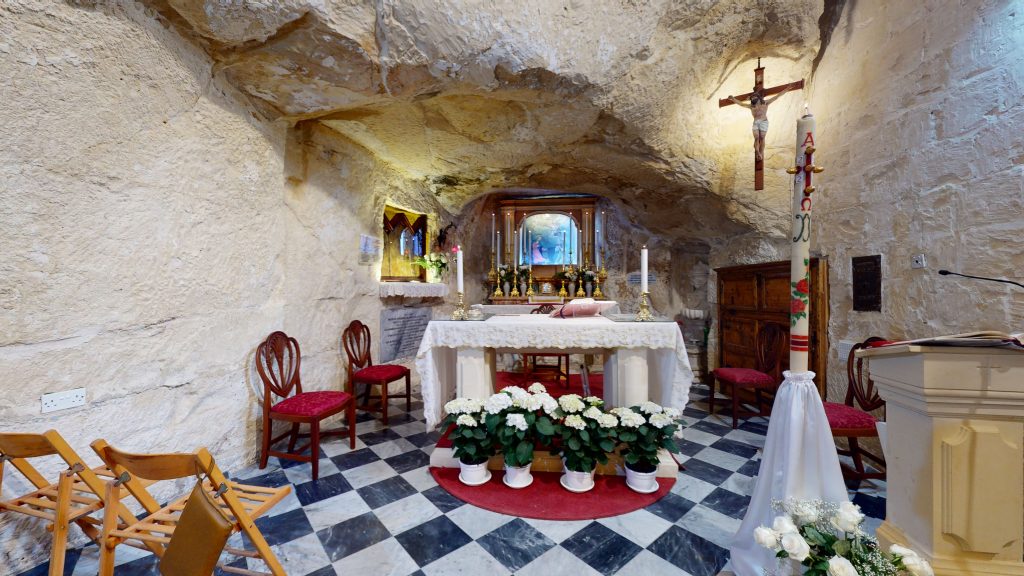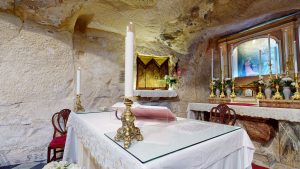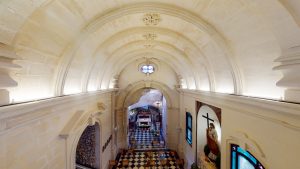
WELCOME!
to
The Chapel of the
Annunciation
and of
St. Leonard

The Legend of Mensija
 With the dawn of the 15th century, so the legend goes, a farmer by the name of Andrea obtained the land that surrounded this cave. He constructed a farmhouse for which entrance one had to descend a few steps, as it was partly embedded in rock. One late evening, the farmer, on entering the abode, observed that a streak of light pierced the underground stone fissures. There and then, Andrea called his family to have a look at this unexplainable light, and the whole family started clearing the subsoil. On reaching the bedrock a big lump of rock dislodged itself, leaving a gaping hole. Looking through this opening, they got the shock of their lives when they saw a three-wick oil lamp facing a sacred image that was still alight.
With the dawn of the 15th century, so the legend goes, a farmer by the name of Andrea obtained the land that surrounded this cave. He constructed a farmhouse for which entrance one had to descend a few steps, as it was partly embedded in rock. One late evening, the farmer, on entering the abode, observed that a streak of light pierced the underground stone fissures. There and then, Andrea called his family to have a look at this unexplainable light, and the whole family started clearing the subsoil. On reaching the bedrock a big lump of rock dislodged itself, leaving a gaping hole. Looking through this opening, they got the shock of their lives when they saw a three-wick oil lamp facing a sacred image that was still alight.
Andrea entered the cave, took hold of the picture and ran straight with it to his parish priest. But the following day, the image mysteriously found its way back to the cave. When the same story happened after a second transportation the kappillan reported the strange happening to his bishop. The latter ordered its delivery to his palace, but again, the image found its way back to the original resting place. Convinced that this was heaven’s will, the bishop ordered a thorough clean-up of the cave, and the provision of an altar. Hearing of such wondrous happenings, people flocked from far and near to devotedly visit the cave and do homage to this miraculous image.
A Historical Glimpse
The whisperings of a ‘golden calf’ legend, hidden in this vicinity might have suggested, somewhat vaguely, the existence of a sacred ‘treasure’ long forgotten. With the disruption of the Pax Romana, Malta entered a truly dark age that became still darker, with a probable persecution of the Christian community, especially during the 9th and 10th centuries. This forced the locals to get some solace underground and therein conceal their cherished devotions. Could this have happened in Mensija?
hidden in this vicinity might have suggested, somewhat vaguely, the existence of a sacred ‘treasure’ long forgotten. With the disruption of the Pax Romana, Malta entered a truly dark age that became still darker, with a probable persecution of the Christian community, especially during the 9th and 10th centuries. This forced the locals to get some solace underground and therein conceal their cherished devotions. Could this have happened in Mensija?
Although the triptych of St. Leonard, with the Archangel Gabriel to his right and the Madonna to his left, may not go beyond the 15th century, it is of Byzantine inspiration. This demonstrates the tenacious habits of the local inhabitants through clinging to their forefathers’ Byzantine connections and traditions.
Perhaps the onrush of widespread devotion in the aftermath of the 17th century was not simply due to the discovery of a triptych, but a rekindling of long lost cherished devotional memories. The combined dedication of St. Leonard (the protector of slaves) and the Annunciation, (the commencement of the Christian era, hence man’s salvation) may be after all, not a mere coincidence, but a well thought message of salvation. The involvement of the farmer’s name Andrea might have inspired the erection of St. Andrew’s chapel that gave the name to the area close-by.
San Ġwann
San Ġwann is a town located on the North Eastern part of Malta, close to St. Julian’s, Sliema and Birkikara. The suburb, that has a population of around 14,000 people, is mainly made up of new buildings and being so close to Sliema and St. Julian’s, San Ġwann provides a cheaper real estate option for both locals and foreigners.
There are a few archaeological remains in the area, suggesting that San Ġwann has an ancient history. There are a pair of cart ruts found near the area of Sant Andrija, whose dating is not definite, bus is assumed to be pre-Punic times, probably carved out during the Bronze Age period from 2300-1000 BC. Their function is also not established but they are usually presumed to be a transport facility. These cart ruts suggest that there was a pre-historic agricultural community living in San Ġwann, who farmed the fertile valleys of Wied Għomor, Wied il-Ballut and Wied Għollieqa.
Later excavations discovered remains from the Roman period including a number of tombs and a covered cistern suggesting an active community. However, the most famous remain is the Roman tower of Ta’ Ċieda. This tower was one of eight defensive towers built around Malta around the third century, and during the Arab period it was used as a cemetery.
The Arab influence in the region can be seen in the Semitic names given to a number of areas such as tal-Għarghar, l-Imsieraħ and the valleys of Wied Għomor, Wied il-Ballut and Wied Għollieqa and many other field localities.
Lanzun Tower was built later to serve as an observation post for advancing planes and was damaged during enemy action. Nowadays, this tower is the seat of the Military and Hospitaller Order of Saint Lazarus of Jerusalem. San Ġwann also hosts the Chancery of the Grand Priory of the Mediterranean of the Hospitaller Order of Saint Lazarus of Jerusalem.
The 1950s brought the Capuchin Friars to San Ġwann. The Friars built a convent and a church dedicated to Our Lady of Lourdes, finished in December 1959. This church was established as a separate parish in 1965.
Today San Ġwann had grown into a residential and commercial centre; in fact, the main road is lined with a number of shops and in the outskirts of the town, an industrial estate has been created, housing a number of factories and manufacturing plants.